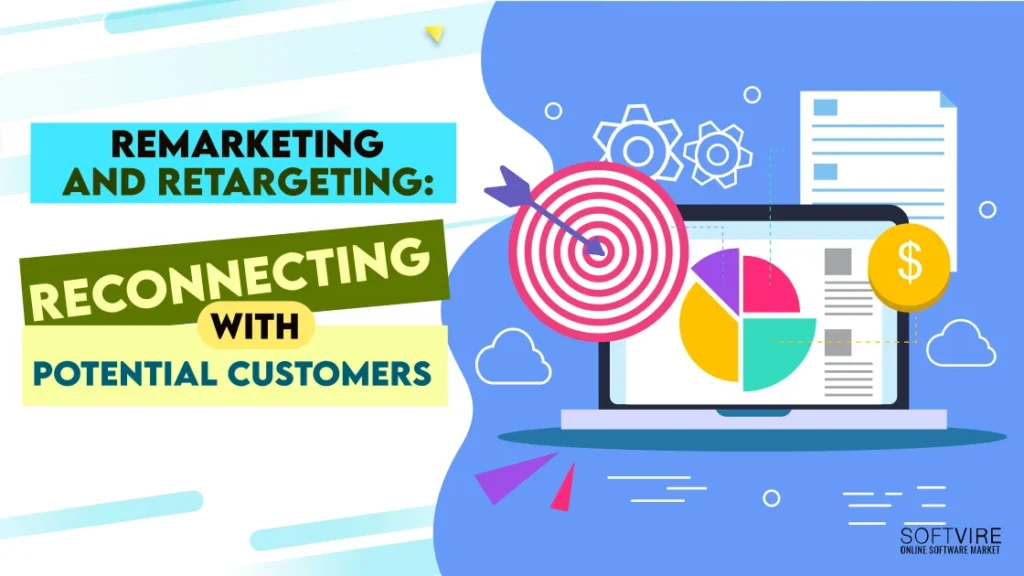I. Introduction
A. Definition of remarketing and retargeting
Remarketing and retargeting are digital marketing strategies aimed at reconnecting with potential customers. Remarketing focuses on targeting previous website visitors through various channels while retargeting involves displaying ads to users who have interacted with a brand, even if they haven’t visited the website.
Both strategies aim to increase brand recall and conversion rates by staying top-of-mind with potential customers.
B. Importance of reconnecting with potential customers
Reconnecting with potential customers is crucial for businesses as it helps nurture relationships, increase brand engagement, and drive conversions. By maintaining communication and personalized interactions, businesses can remind potential customers of their offerings, address their needs, and build trust, ultimately maximizing the chances of turning them into loyal customers.
II. Understanding Remarketing and Retargeting
A. Difference between remarketing and retargeting
Although remarketing and retargeting are frequently used interchangeably, they have significant differences.
- Remarketing: Remarketing targets previous website visitors through various channels, such as email or ads, to encourage them to return and complete desired actions. It involves reaching out to individuals who have already shown interest in a brand or product.
- Retargeting involves displaying ads to users who have interacted with a brand, even if they haven’t visited its website. It goes beyond website visitors and can target users based on their interactions on social media, search engines, or other platforms.
B. How remarketing and retargeting work
Both remarketing and retargeting strategies rely on tracking pixels or tags that collect user data to identify individuals who have engaged with a brand. These strategies typically follow a three-step process:
- User Engagement: When a user visits a website or interacts with a brand’s online presence, a tracking pixel or tag is activated, capturing information such as website visits, product views, or abandoned carts.
- Audience Segmentation: Businesses can segment users into different audience groups based on the captured data. Segmentation can be based on behavior, demographics, interests, or specific actions taken on the website.
- Targeted Messaging and Ads: With segmented audience data, businesses can create customized ads or messages tailored to each audience group. These ads are then displayed through various channels, such as email, display advertising, or social media platforms, to re-engage potential customers and drive conversions.
C. Benefits of using remarketing and retargeting strategies
Remarketing and retargeting strategies offer several benefits for businesses:
- Increased Brand Recall: By staying top-of-mind with potential customers through targeted ads and messages, remarketing and retargeting strategies help increase brand recall and recognition.
- Improved Ad Relevance: These strategies allow businesses to deliver highly targeted and relevant ads to specific audience segments, increasing the chances of capturing their attention and driving engagement.
- Higher Conversion Rates: Reconnecting with potential customers who have already shown interest in a brand or product significantly improves the likelihood of conversion. Remarketing and retargeting strategies can drive higher conversion rates by reminding and enticing them to take the desired action.
- Cost-Effectiveness: Remarketing and retargeting can be cost-effective compared to broader advertising campaigns since they focus on targeting individuals who have already demonstrated interest.
- Personalized Customer Experience: By tailoring ads and messages to specific audience segments, businesses can provide a more personalized and relevant customer experience, fostering stronger connections and enhancing customer satisfaction.
III. Setting Up Remarketing and Retargeting Campaigns
To effectively implement remarketing and retargeting campaigns, businesses should follow a structured approach that includes the following steps:
A. Defining campaign objectives and goals
- Clearly define the desired outcomes and objectives for the remarketing and retargeting campaigns. This could include increasing conversions, driving repeat purchases, or promoting specific products or services.
- Set measurable goals, such as target conversion rates, click-through rates, or return on ad spend (ROAS), to track the success of the campaigns.
B. Identifying target audience segments
- Segment the target audience based on specific criteria, such as their behavior on the website, previous purchase history, or demographics.
- Identify different audience segments that align with the campaign objectives. For example, segmenting users who abandoned their shopping carts versus those who purchased can help tailor messaging accordingly.
C. Placing tracking pixels or tags on relevant platforms
- Implement tracking pixels or tags on the relevant platforms where the audience interacts with the business, such as the website, mobile apps, or social media platforms.
- Tracking pixels collect user data and help identify individuals who have engaged with the brand, allowing for effective remarketing and retargeting.
D. Creating customized ads for different audience segments
- Tailor ad content and messaging to each audience segment based on their preferences, behavior, or previous interactions.
- Make the advertising more relevant and enticing to the target audience by using dynamic content and customized recommendations.
- Implement variations in ad creatives, such as images, headlines, or calls-to-action, to test and optimize performance.
IV. Implementing Remarketing Strategies
Remarketing strategies encompass various channels and approaches to reconnect with potential customers who have previously shown interest in a business. Here are some effective tactics for implementing remarketing strategies:
A. Targeting website visitors
Reaching out to visitors who abandoned the site
- Identify users who visited the website but left without completing a desired action, such as purchasing or filling out a form.
- Display targeted ads or send personalized emails to remind them of their initial interest and encourage them to return.
Cross-selling or upselling to previous customers
- Leverage the existing relationship with previous customers to introduce related or upgraded products or services.
- Display tailored recommendations or offers that align with their previous purchases or browsing history.
B. Engaging with email subscribers
Sending personalized and targeted emails
- Segment email subscribers based on their preferences, behavior, or demographic information.
- Craft personalized emails that address their needs, highlight relevant products or services, and provide valuable content.
Offering exclusive promotions or discounts
- Provide email subscribers with exclusive offers, discounts, or promotions to incentivize them to act.
- Create a sense of urgency by setting limited-time offers or limited availability for the promotions.
C. Reconnecting with app users
Sending push notifications or in-app messages
- Utilize push notifications or in-app messages to re-engage app users who have been inactive for a certain period.
- Send personalized and relevant messages to entice them to open the app and take specific actions.
Offering incentives for re-engagement
- Provide incentives, such as exclusive content, rewards, or discounts, to encourage app users to re-engage with the app.
- Implement loyalty programs or gamification elements to drive continuous engagement.
V. Retargeting Across Advertising Platforms
Retargeting efforts extend beyond the website and encompass various advertising platforms. By leveraging these platforms, businesses can effectively reconnect with potential customers. Here are some key strategies for retargeting across advertising platforms:
A. Utilizing display advertising
Displaying ads on websites and apps visited by potential customers
-
- Identify websites and apps that are frequently visited by the target audience.
- Display retargeted advertising on various channels to enhance visibility and catch potential buyers’ attention.
Customizing ad creatives to increase relevancy
-
- Tailor ad creatives to match the target audience’s interests, preferences, or previous interactions.
- Display specific products, personalized offers, or messages that align with their needs and increase relevancy.
B. Leveraging social media platforms
Displaying advertisements to users who have interacted with the brand
-
- Target users who have engaged with the brand’s website, social media pages, or other online assets.
- Display retargeted ads to remind them of the brand and encourage further engagement or conversions.
Using dynamic product ads for personalized retargeting
-
- Utilize dynamic product ads that automatically display relevant products based on the user’s browsing history or previous interactions.
- Tailor ad creatives to showcase products that the users have shown interest in, increasing personalization and relevancy.
C. Integrating search engine retargeting
Displaying ads to users who have shown interest in specific keywords
-
- Identify keywords that indicate user intent or interest in the brand’s products or services.
- Display retargeted ads to users who have searched for or clicked on relevant keywords, reminding them of the brand’s offerings.
Optimizing ad campaigns based on search intent
-
- Analyze user search behavior and intent to optimize ad campaigns.
- Tailor ad messaging and targeting to align with specific search intents, increasing the relevance and effectiveness of the ads.
VI. Measuring and Optimizing Remarketing and Retargeting Efforts
Measuring and optimizing the efforts continuously is essential to ensure the effectiveness of remarketing and retargeting campaigns. Here are key steps for measuring and optimizing remarketing and retargeting efforts:
A. Tracking key performance metrics
Click-through rate (CTR) and conversion rate
-
- Monitor the CTR to gauge the effectiveness of ad creatives in capturing user attention.
- Measure the conversion rate to assess the campaigns’ success in driving desired actions.
Cost per acquisition (CPA) and return on ad spend (ROAS)
-
- Calculate the CPA to determine the cost-effectiveness of acquiring new customers through remarketing efforts.
- Evaluate the ROAS to measure the return on investment and determine the profitability of the campaigns.
B. Conducting A/B testing
Testing different ad variations and messaging
-
- A/B tests should be performed to compare the performance of different ad variations, such as visuals, headlines, or calls-to-action.
- Identify which elements resonate best with the target audience and optimize accordingly.
Optimizing landing pages for better conversion rates
-
- Test different landing page layouts, designs, or content to improve the conversion rates of remarketing campaigns.
- Analyze user behavior on landing pages and make data-driven optimizations to enhance the user experience and increase conversions.
C. Continuously refining targeting and segmentation
Analyzing audience data and behavior patterns
-
- Regularly analyze audience data, including demographics, interests, and engagement patterns.
- Identify trends and patterns to refine audience segmentation and improve targeting accuracy.
Adjusting campaigns based on insights and performance
-
- Use insights gained from data analysis to make informed adjustments to ad campaigns.
- Optimize targeting parameters, ad placements, or bidding strategies based on performance metrics and audience behavior.
VII. Privacy and Data Considerations
While implementing remarketing and retargeting strategies, it is crucial to prioritize privacy and data protection. Here are considerations to ensure compliance and safeguard customer data:
A. Ensuring compliance with privacy regulations
- Familiarize yourself with relevant privacy regulations, such as the General Data Protection Regulation (GDPR) or the California Consumer Privacy Act (CCPA).
- Ensure that remarketing and retargeting practices align with the requirements outlined in these regulations.
B. Obtaining consent and providing transparency
- Obtain explicit consent from users for tracking and targeting purposes.
- Communicate how their data will be used and provide options for opting out of remarketing efforts.
- Maintain transparency in data collection, storage, and usage practices.
C. Safeguarding customer data and maintaining security
- Establish strong security procedures to protect customer data from unauthorized access, breaches, or misuse.
- Follow industry best practices for data encryption, secure storage, and access controls.
- Regularly update and patch software and systems to address any potential vulnerabilities.
Conclusion:
Remarketing and retargeting are effective strategies businesses can use to reconnect with potential customers and drive success. These strategies involve delivering personalized ads and messages to engage users interested in a brand.
By utilizing these strategies, businesses can increase engagement, deliver personalized experiences, optimize campaigns, and build customer trust. Reconnecting with potential customers through remarketing and retargeting is crucial for long-term business success in today’s competitive landscape.
Check out the different Microsoft software products today if you need trusted software that uses AI ethically and efficiently. Softvire continues to lead in using AI for its many office tools like Office 365. Get discounted Office 365 in Australia now!



